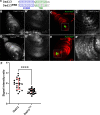midline represses Dpp signaling and target gene expression in Drosophila ventral leg development
- PMID: 35608103
- PMCID: PMC9167623
- DOI: 10.1242/bio.059206
midline represses Dpp signaling and target gene expression in Drosophila ventral leg development
Abstract
Ventral leg patterning in Drosophila is controlled by the expression of the redundant T-box Transcription factors midline (mid) and H15. Here, we show that mid represses the Dpp-activated gene Daughters against decapentaplegic (Dad) through a consensus T-box binding element (TBE) site in the minimal enhancer, Dad13. Mutating the Dad13 DNA sequence results in an increased and broadening of Dad expression. We also demonstrate that the engrailed-homology-1 domain of Mid is critical for regulating the levels of phospho-Mad, a transducer of Dpp-signaling. However, we find that mid does not affect all Dpp-target genes as we demonstrate that brinker (brk) expression is unresponsive to mid. This study further illuminates the interplay between mechanisms involved in determination of cellular fate and the varied roles of mid.
Keywords: Dpp-signaling; Limb development; T-box transcription factors; Tissue patterning.
© 2022. Published by The Company of Biologists Ltd.
Conflict of interest statement
Competing interests The authors declare no competing or financial interests.
Figures




Similar articles
-
The selector genes midline and H15 control ventral leg pattern by both inhibiting Dpp signaling and specifying ventral fate.Dev Biol. 2019 Nov 1;455(1):19-31. doi: 10.1016/j.ydbio.2019.05.012. Epub 2019 Jul 9. Dev Biol. 2019. PMID: 31299230
-
A combinatorial enhancer recognized by Mad, TCF and Brinker first activates then represses dpp expression in the posterior spiracles of Drosophila.Dev Biol. 2008 Jan 15;313(2):829-43. doi: 10.1016/j.ydbio.2007.10.021. Epub 2007 Oct 24. Dev Biol. 2008. PMID: 18068697 Free PMC article.
-
Direct transcriptional control of the Dpp target omb by the DNA binding protein Brinker.EMBO J. 2000 Nov 15;19(22):6162-72. doi: 10.1093/emboj/19.22.6162. EMBO J. 2000. PMID: 11080162 Free PMC article.
-
T-box genes organize the dorsal ventral leg axis in Drosophila melanogaster.Fly (Austin). 2010 Apr-Jun;4(2):159-62. doi: 10.4161/fly.4.2.11251. Epub 2010 Apr 18. Fly (Austin). 2010. PMID: 20215860 Review.
-
T-Box Genes in Drosophila Mesoderm Development.Curr Top Dev Biol. 2017;122:161-193. doi: 10.1016/bs.ctdb.2016.06.003. Epub 2016 Jul 30. Curr Top Dev Biol. 2017. PMID: 28057263 Review.
References
Publication types
MeSH terms
Substances
LinkOut - more resources
Full Text Sources
Molecular Biology Databases

